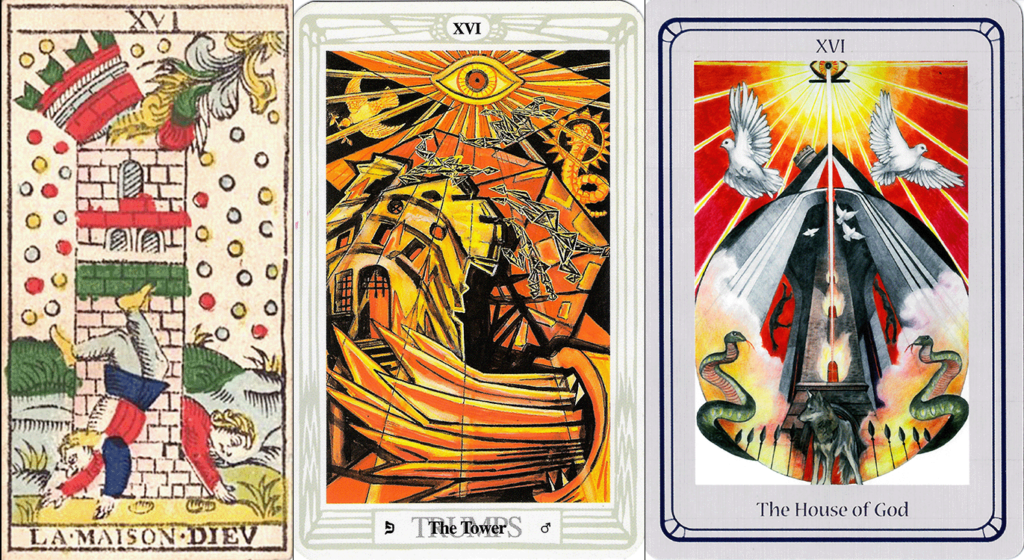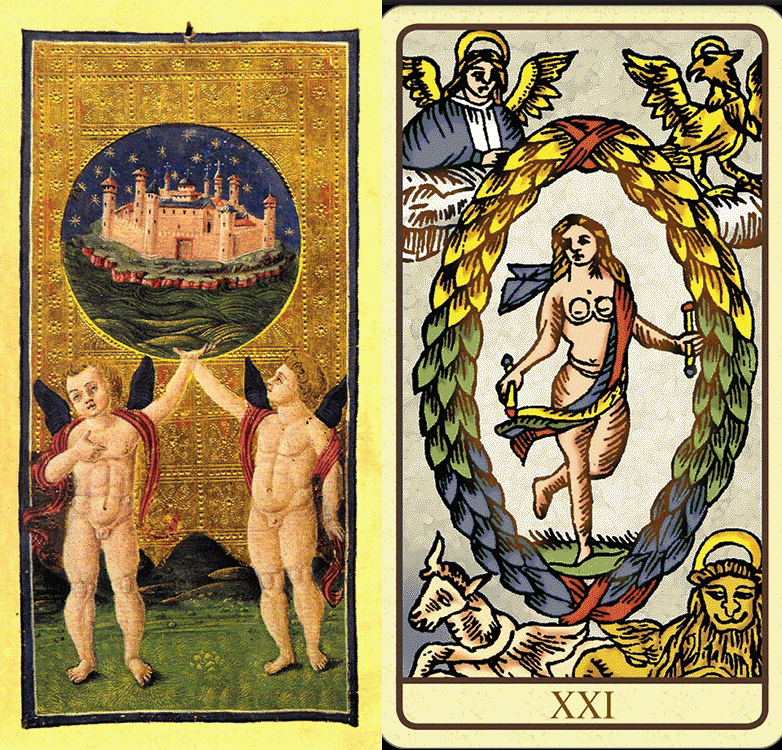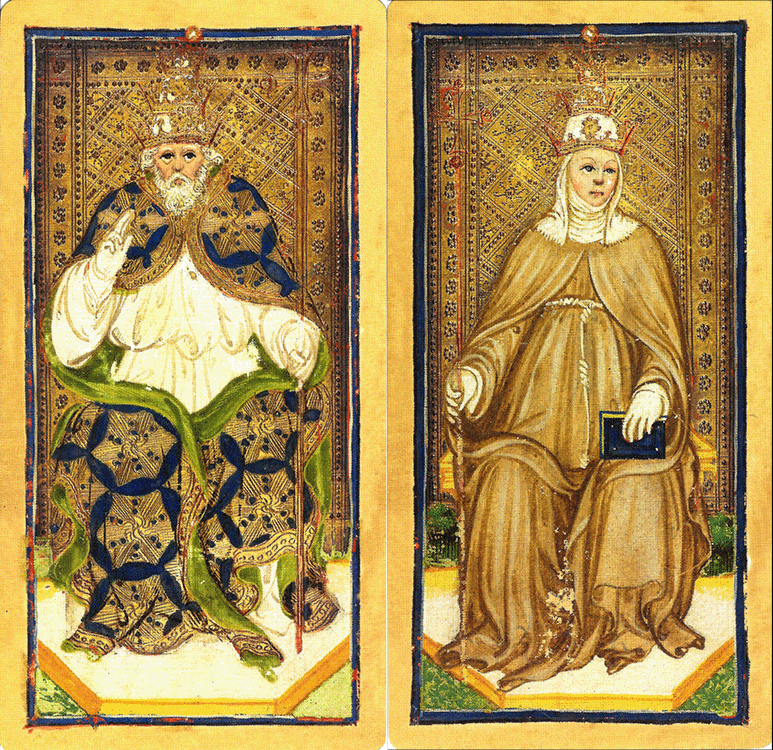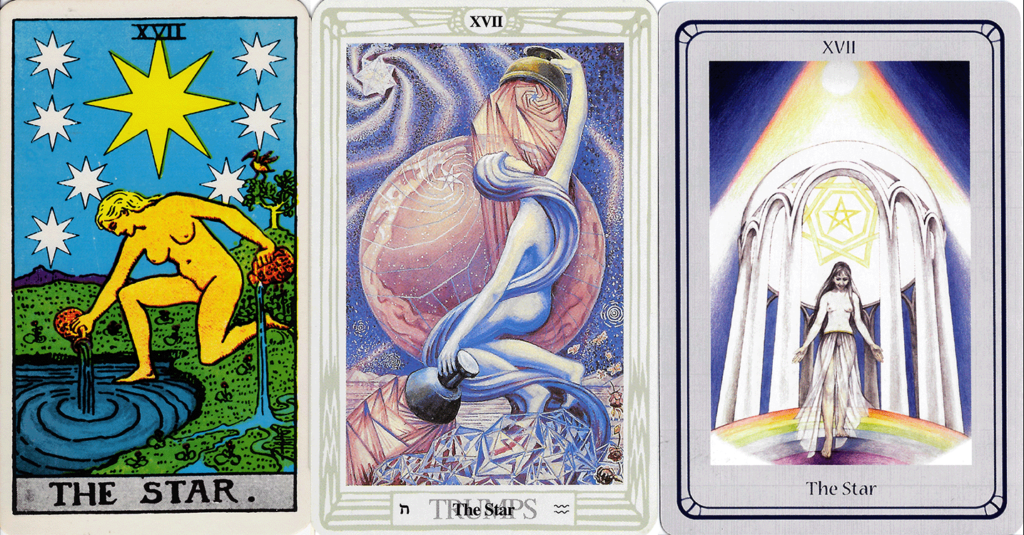This week I’m back home and back in my Tarot decks working with the dreaded and feared Tower card.
People seem to have become more apprehensive regarding this card than the Devil or even Death. In modern times, when Death is almost universally presented as “not really death”,1Though, yeah, it’s still also really Death. the Tower now represents the introduction of catastrophe and loss in our lives. Yet this interpretation is a surface reading only.
While the card is dynamic, even chaotic, it need not be cataclysmic. It all depends on one’s perspective. We need to go back beyond Waite and even Eliphas Levi, and look at how this card emerges from history.
I recently added a reproduction of the Visconti-Sforza Tarocchi deck to my collection. This set is the best preserved of the Renaissance cards created in Italy. A large part is kept in the collection of the J. Pierpont Morgan Library in New York City, where I purchased my copy.

Curiously, though, the background leafing work seems to have been done by the same person, so this argues that a number of blanks were commissioned at one time, in consideration of lost or damaged cards.
One of the many curious things about this deck is that both the Tower and Devil were executed by a different artist, presumably at a later date.
In fact extant versions of either card are missing from many early decks, which has lead some people to speculate that they didn’t form a part of the game until later.
While on the surface this might sound odd, the fact is that multiple Tarocchi decks with greater or fewer numbers of trionfi cards do exist. Variations are regional and potentially socio-political in some cases and some had as many as 40 special cards, and as few as 16.
By the time the cards start being mass produced across the border in France, the game of Tarot has pared down to the extant 22 major arcana that include a Devil and what Waite introduced into modern occultism as the Tower.
But in the Tarot of Marseilles, which Eliphas Levi based his Tarot work upon, this card is called La Maison Dieu – The House of God.

Crowley’s Thoth deck borrows from Cubism and Abstract movements to display greater chaos and destruction. Yet in the background Lady Freida has added Noah’s dove and the Kundalani Serpent, indicating a spiritual liberation is taking place, despite the yawning hellmouth at the bottom of the image.
The Via Tarot, conceived a little less than two decades ago, but based upon Thelemic ideology, restores the name House of God to this card, It retains the All Seeing Eye from the Thoth deck, and the dove and serpents are reflected, flanking a wolf at the door. The imagery is more ordered than other Tarot depictions, speaking of a transformation through structure.
This is at least a curious appellation for a card connected with destruction and chaos. Or maybe not.
I’ve scoured the webs for historical support for this naming. Most of what comes up is opinion or dogma.
Curiouser still is that with this title, it comes on the heels of the Devil. Surely something called the House of God might be better placed up around card XX – Judgment, with it’s apocalyptic angel calling the dead from their graves.

It’s rather ironic that the world of the Visconti-Sforza was Biblical supported by more or less pagan sprites, whereas the Marseille (and most later decks) have a pagan World surrounded by Christian iconography.
Yet neither the image or location make much sense with this title. So perhaps we should delve into possible sources for the image. The most obvious, to my thinking, is the story of the Tower of Babel.
This is one of the “Just So” stories found in the Old Testament book of Genesis, which explains why all the people who were descended from the survivors of the Flood ended up speaking different languages.
After departing the ark and doing a lot of begatting, humanity was more or less a big happy family. So they got together to build a mighty city with a “tower that would reach up to heaven”.
God, not being disposed to uninvited visitors at the time, causes them to all start speaking in tongues. Unable to understand each other, they are forced to abandon the building project and wander off in multiple directions.
The moral of this story is one of humility and submission to a higher will. But what does that have to do with the Tower card?
Well, we can draw a fair parallel to the destruction of this medieval tower, by fire or lightning or some other “heavenly force” as God asserting dominion over all the works of humankind. That’s a very basic tenet of the faith. God is a lot bigger than us, and consequently he will tell us what to do and we’ll like it.
The Visconti-Sforza Tarot were a luxury item. They were commissioned by a wealthy semi-noble merchant family, to wile away the hours that only wealthy semi-noble merchant families could afford. One way of wiling away the hours in the Renaissance was cultivating secular humanism. That is, the stranglehold of the Holy Mother Church on philosophical thought was loosening, thanks to the importation of old Greek and Latin works from the Islamic Empires via the Silk Road and Moorish Spain.
In fact, playing cards most likely came via Islam (potentially adapted from China). The familiar suits of Wands, Cups, Swords, and Coins exist on decks from Northern Africa at this time. There’s not a lot of history of the early games played with these cards, which were all pips. Islamic belief forbids the depiction of people. Since only Allah has the power to create a human being, to show them in art (or even photography) is considered to be mocking the divine.
So it’s likely the face cards were added in Italy. along with the trionfi2This Italian word translates as “triumph” and predates the word “trump” referring to major arcana cards, as the latter has become something of a trigger these days.. This made possible complex games where the special cards counted for points.
I’ve read a version of Tarocchi rules (and my head hurts now) but essentially the different designs on the cards allowed for varying point values, and like bridge, the ones with the most points at the end were the winning team. I don’t understand bridge, either, nor most card games, so if this is grossly misstated, sorry.
Which takes us back to secular humanism. The imagery on the oldest trionfi are an odd mix. We have the Juggler, who later becomes the Magician. But in the Visconti-Sforza he is neither juggling nor being particularly magical.
He does have, on his table, a glass, two coins, a knife, and is resting the bottom of a staff. Hence we characterize these in the modern decks as representative of the four suits. But that fuzzy thing on the end of the table is identified by the Morgan collection as a hat form.
Whilst I can imagine a juggler using the objects of the suits in performance, I cannot fathom what a hat form has to do with juggling or magic…unless, of course, a rabbit is involved. In the Marseilles Tarot it’s become a kit bag or purse, which perhaps makes more sense, and in Pixie Smith’s version, it’s gone entirely.
I think perhaps the images here participate in certain “in-jokes” or metaphors that we don’t fully comprehend in the present world, but that were well understood by the wealthy semi-noble card sharps.

Yet these figures depicted in Visconti Sforza show equal rank, as proven by both wearing the triple crown of the Holy Trinity. The Pope is arrayed in guilded finery with velvet lining. The Popess, on the other hand, aside from crown and kid gloves, adopts the habit of a monastic. Some have cast her as a symbol of “Mother Church” but perhaps we can see her plain and poor mantle as emblematic of the inner faith, bereft of worldly adornment. Whilst the Pope raises his right hand in benediction, the Popess clutches a closed book in her left hand.
There’s more going on here than simple parody.
For example, we have both Pope and Popess3There is some speculation that the Popess card alludes to, and possibly depicts, a heretical ancestor of the Sforza duchess who commissioned these cards. You can read more about it here., which in Medieval times could have gotten you handed over to the Inquisition.
Not so with secular humanism. You can parody the Church (or rather the church without capitalization). It’s just another part of the human experience, no more divine or sacred than your breakfast or the daily trip to the garderobe. It’s hard to imagine that cheery corpse on the Death card in light of a friendly game of cards, unless the social context is that we’re not taking it at all seriously, After all, we are the wealthy semi-noble merchant families and the rest of the world can just kiss it.
So maybe that Tower card wasn’t missing from the older decks. Maybe it wasn’t there at all. Maybe it got put back in, along with Ye Aulde Divel card, to remind these prideful secular humanists of the error of their ways. There are a number of Tarocchi decks that contain trionfi of the traditional virtues and vices, so there seems to have been some effort by the princes of the church to regain control of their flocks (and the attendant tithes). The Tower of Babel is a pretty good metaphor for “pride goeth before a fall”.
There’s an alternate theory that “House of God” is something of a parody against a corrupt church, much the same as the Popess can be seen as mocking a traditionally patriarchal organization. But I have a problem with that.
The images of the Tower are showing secular buildings. Churches have a very distinctive architectural style, and that isn’t it. These are symbolic of Medieval fortifications, and in some versions one of the falling figures wears a crown. So it does argue for this being more a convention of the church attempting to show the collapse of the secular humanist state.
But what if perhaps this is referring to the Apocalypse of the Revelation of St. John? Perhaps here we have a portrayal of the human world being swept away to make way for the “Heavenly Jerusalem” that will descend upon earth after the sinful are cast down into Hell. Crowley seems to ascribe to this interpretation somewhat. He had Lady Frieda Harris include the Mouth of Dis at the bottom of his card. This is a variation of the opening of the Pit shown in the Medieval Das Buch Belial and copied to many others.
It can be a confusing mess, because regardless of our post modern New Age mentality, we have to reckon with works that came out of rigid Catholic cultures, overlain with Hebrew, Hindu, Taoist, and Buddhist mysticism (perhaps incorrectly) and re-reinterpreted through the lens of Victorian Christianity. It’s not unfair to say that the occultists of the late 19th century were motivated to “discover” ancient hidden traditions whether they were there or not. The field was fiercely competitive, and wide open to the cult of personality.
Despite this, esoteric interpretations almost uniformly ascribe this card to the failure and ultimate removal of old established orders. On an individual level, the Tower describes a trauma so profound that the only way to recover is discarding most of the old preconceptions and rebuilding from scratch.
But like most Tarot, there’s other possible interpretations. The cards never exist in a vacuum. They are always influenced and augmented by the others around them.

The only way to escape the doom of the Tower card is to change our place in the narrative. We can either be the Tower, or we can be the Lightning.
We have been trained to view the Tower as though we are the one’s falling from it’s height, or being crushed under the collapse. Waite’s Victorian pessimism sought to insure readers never ran short of ill omens. And bad cards could come up reversed, so in that binary thinking the upside down Tower was a good thing.
But we don’t have to be the victims. That’s part of the last throes of heavy Christian thinking that still informed the occultists of the 19th and early 20th Centuries. In this context the lightning is an external force beyond our control that brings down all that we see as divine retribution for our hubris. It’s the same crime and sentence resulting in the confusion of Babel or Lucifer being cast into the Pit. We should recognize the source of that and move on.
It is possible to see oneself as the active principle initiating profound change. In this scenario, we lead our own transformation, and the transformation of the world around us, rather than being pummeled by the debris of the falling tower. We can choose to be the Lightning.
Depending on how it falls in a reading, the Tower card can speak of manifestation. It can signal that we are changing bad habits and rising above failed choices. As pointed out by H.Byron Ballard on a recent New World Witchery podcast, the Tower is predecesory to the Star. The question is whether we emerge into the Star, or the Star Reversed.
I hope for the Star. If one looks at the Tower Reversed, it’s usual meaning is more compatible with the Star Reversed, a continuation of narrow-mindedness, parsimony, and general self-doubt, brought about by oppression and unjustness. This also applies if we are the dynamic force of Celestial Fire in the Tower. The reversal has that energy trapped at the bottom of a great pit, with darkness all around, and the figures are still falling.

While not perhaps obvious, there is a subtle connection between the Thoth Tower and Star Cards. The lightning bolt that fills the Tower’s background is mirrored in the composition of figure, water and Star. The bright orange tones that dominate the Tower are transmuted here into complimentary blues and purples. The Star is an opposite that emerges serene from the fiery madness of the Tower.
In the Via deck, we also have echoes of the preceding imagery. The rays of light from the All Seeing Eye remain, only as an afterglow, illuminating the double Star in the dome of a newly minted structure, occupied by a single pacific spirit treading the light of the rainbow. The anger has been washed away. Only the rainbow remains to remind us the storm has passed.
Next week I’ll be back with more fresh weirdness after the Solstice (Summer or Winter depending on your latitude). In the meantime, please feel free to read (or re-read) my previous articles on my recent experience in Salem, Massachusetts, and on the effects of Mercury retrograde (which thankfully will be completely over by then). As always, thank you for the taking the time to read this.

